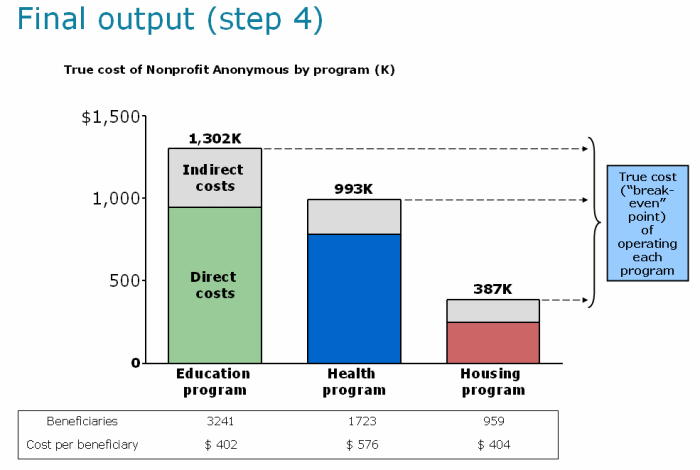Once you have decided on the time period and programmatic scope of your analysis, you can begin gathering the relevant data accordingly.
Next In: Nonprofit Cost Analysis Toolkit
In this step, you will allocate indirect costs in a meaningful way across the program areas you specified in step one. Indirect costs are costs shared across several programs; they include any expenses that are not directly tied to the operation of a specific program and that, therefore, have not been distributed in the previous step. Indirect costs can include general administration and management expenses (e.g. management staff salaries and benefits), infrastructure costs (e.g. rent and utilities, transportation, equipment depreciation, technical licenses), and other costs that are incurred for the benefit of all the programs within the organization (e.g. marketing costs, advocacy expenses).
In order to allocate indirect costs, you’ll need to do two things:
- Identify “drivers” for each cost item
- Using the drivers, allocate indirect costs to programs
Identify drivers
Cost drivers are measurable factors that allow you to determine the relationship between the indirect cost and each program area, and may vary for different cost items. Think of them as the variables that cause a particular indirect cost to grow or decrease. For instance, rent for an office space often varies depending on the number of staff members that need to be in a particular location: the more people in an office, the larger the space (and so the rent) needs to be. Thus, number of people is a good cost driver for the rent line item.
The appropriate driver may be different for each cost item, depending on what is the root unit that drives that particular expense, and it is up to you to determine the most relevant driver for your costs. By looking at how many units of cost driver a particular program has/uses, you can determine what a fair allocation of the indirect cost to that program is.
For example:
- Cost item: salary/benefits of the human resource director (HR)
- Guiding question: What unit can approximate the demand that each program places on the HR director? (i.e. How do we meaningfully distribute the HR director’s time across programs?)
- Cost driver: number of staff working directly on each program, in that the more people there are, the more time the HR director will need to spend working on a particular program
- Allocation method: translate the number of staff working on each program into a percentage of the HR director’s total time (e.g. 20 percent of time on education program staff (two people); 30 percent on health program staff (three people); 50 percent on housing program staff (five people) (For a more complete list of guiding questions and examples, see:)
Sample Cost Drivers (Word)
Wherever appropriate, it is best practice to use the same driver for multiple line items in order to keep your analysis as simple as possible. A total of six cost drivers is easier to manage than calculating 20 different ones.
For those cost drivers that you feel less confident about, check with someone else in your organization to see if the drivers you are considering make good intuitive sense (i.e. if other people had to define this cost driver, would they pick the same one you did?). This will help ensure the accuracy of your cost analysis results.
Allocate indirect costs
Using the allocation method defined in the previous section, distribute each cost item across the program areas according to the estimated percentages.
Continuing with the previous example:
- Cost item: salary/benefits of the HR director= $100K
- Allocation method: 20 percent of HR director’s time is spent on education program staff; 30 percent on health program staff; 50 percent on housing program staff
- Allocated indirect costs: $20K to education; $30K to health; $50K to housing
- Repeat the process for all the indirect cost items until you have allocated all the overhead costs into the appropriate program areas
The information you have gathered gives the true price of operating each of your programs, which can be graphically depicted as:

-
Indirect Cost Allocation Template (Excel)
-
Indirect Cost Allocation Sample (Excel)

